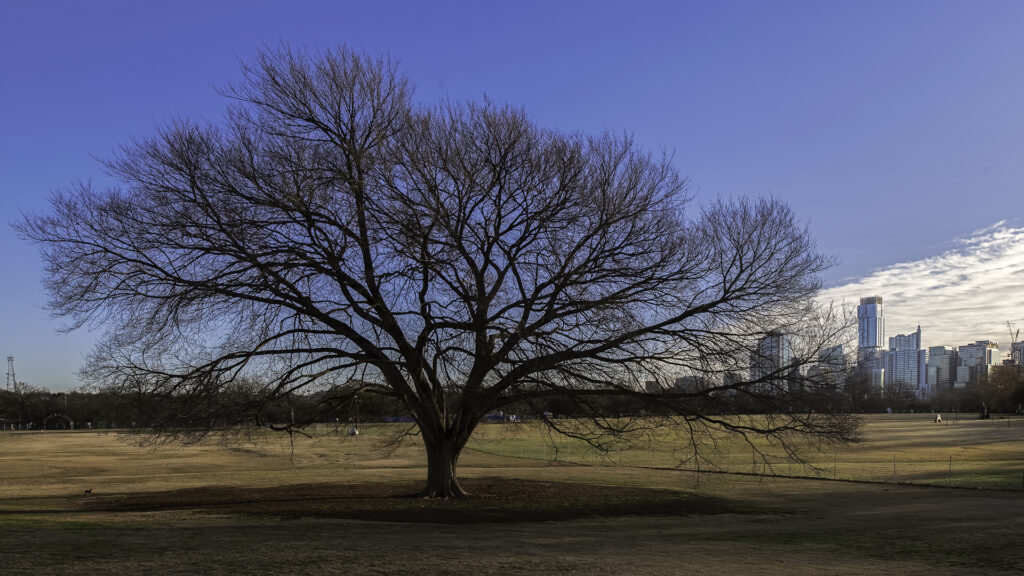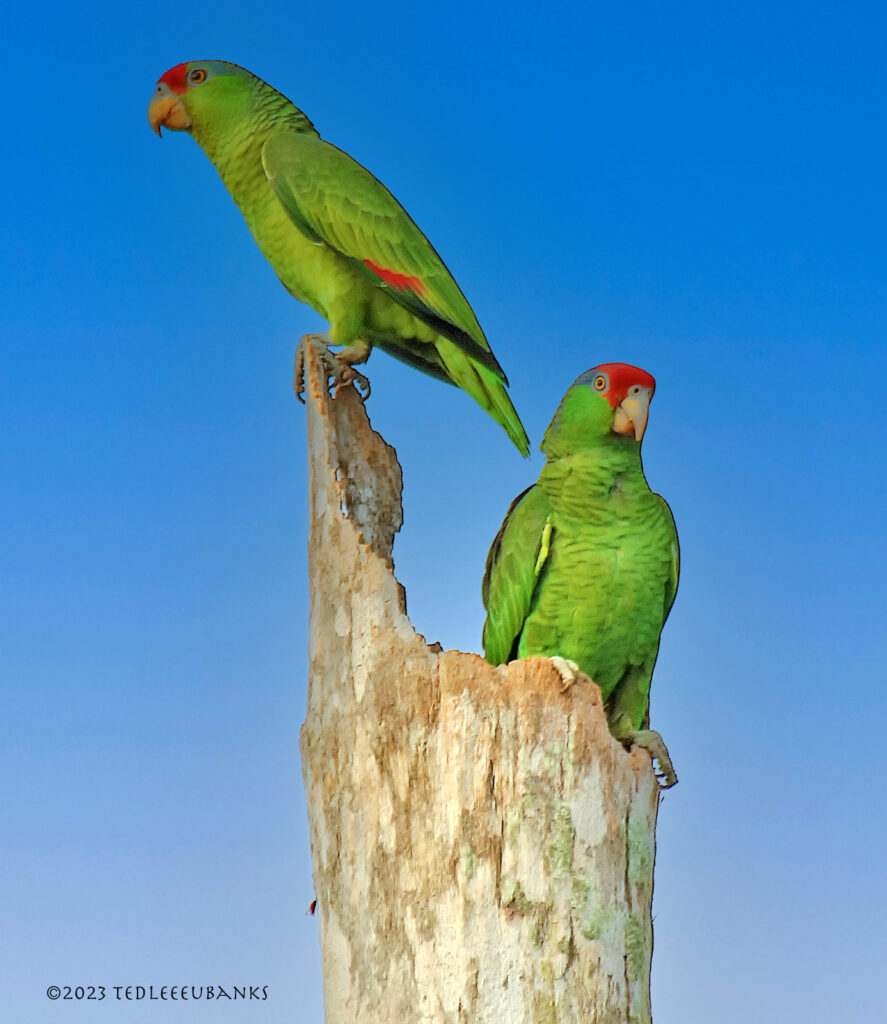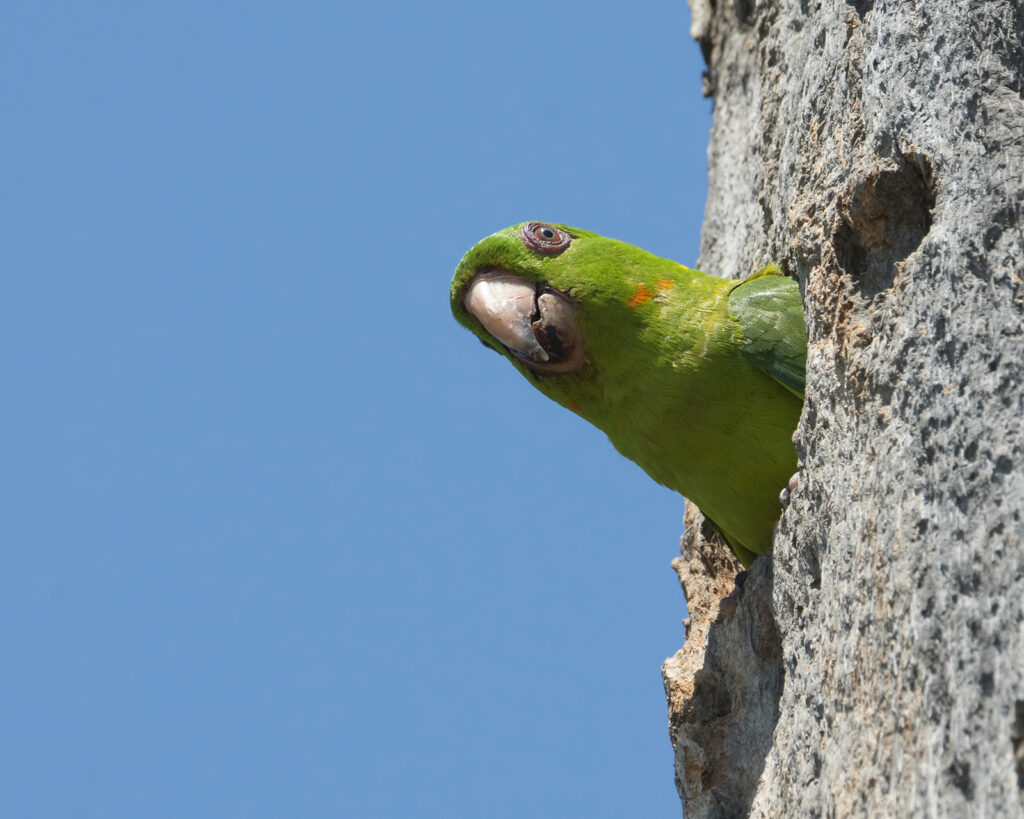
The red-crowned parrot (Amazona viridigenalis) is an endangered parrot from northeast Mexico that has recently extended (or returned) its range to the lower Rio Grande Valley (Valley) of South Texas. These parrots are only found in the U.S. in the Valley, with numbers congregating in towns such as McAllen and Brownsville. The red-crowned parrot, along with the green parakeet, are endemic, singular. And, like so many neotropical birds that range no farther north than South Texas, they are found at the Quinta Mazatlan World Birding Center (Quinta).

In the earliest days of the World Birding Centers project, I developed vision plans for many of the communities hoping to participate. Our plan for Mission, for example, focused on butterflies and led to the National Butterfly Center there along the border. In Weslaco, our vision plan convinced the city to participate in what has become the Estero Llano Grande State Park. In South Padre, our vision plan helped the city attract state funding to building the South Padre Birding and Nature Center.
At Quinta, our early work focused on an interpretive plan as well as exhibits within the nature center. Larry Pressler, then head of McAllen Parks and Recreation, asked us to develop the interpretive plan and implementation in 2005. Larry had been instrumental in buying Quinta Mazatlan for McAllen at a last-minute auction of the property. Several years later, Quinta asked me to develop a vision plan for the next phase of the park. Last week, the City of McAllen presented the final design for this expansion to the public.

Let’s stop for a moment and think about McAllen and Quinta. The population of McAllen is around 150,000, with 86.2% of the population being Latino or Hispanic. McAllen is 11 miles from the Mexican border. McAllen’s average household income is half of Austin’s. The average median household income in McAllen is $54,422, while Austin’s is $110,300.
McAllen has few of Austin’s advantages. Yet, McAllen is about to build an expansion to a city park that will result in one of the most spectacular civic spaces in Texas while retaining public ownership of the park.
Here is an example of what is to be expected in this new park expansion. This information is from the City of McAllen website.
- The project is supported by Texas Parks & Wildlife, as the Center for Urban Ecology (CUE) is being designed to attract both people and wildlife.
- The expansion includes the planting of over 24,000 new native plants, over 90% native to the Lower Rio Grande Valley.
- A five-acre Children’s Discovery Park and an innovative curriculum to use the Center for a big outdoor learning lab will be made possible through a partnership with McAllen ISD.
- An interactive model—a physical metaphor of the Rio Grande River from Colorado to the Gulf of Mexico, will be made possible with the support of the McAllen Public Utility.
- Children and all visitors will enjoy the Vantage Point, an outdoor amphitheater and educational exhibit deck sponsored by Vantage Bank Texas, Loring Cook Foundation, and the James W. & Kathleen C. Collins Family Foundation.
- Additional attractions include the H-E-B Health & Wellness Pavilion for demonstrations on healthy cooking, yoga and more.
- The Economic Development Administration is supporting the teaching spaces for entrepreneurial and global tourism opportunities at the CUE.
- Finally, the transformative project will feature a Metro McAllen Park & Ride, encouraging the use of public transportation. According to the City of McAllen; “The project, in the amount of $51.9 million, will transform the 12 acres of the nature sanctuary, into an educational space. This landmark project could not be made possible without the support from the State of Texas, Texas Parks and Wildlife, Hidalgo County, and UTRGV – The University of Texas Rio Grande Valley.”

For those who may not be aware, the Valley is a birding “hotspot,” one of those places where birders from all over the U.S. and foreign countries such as England and France travel to visit and see birds (and nature in general) that are simply not possible to encounter anywhere else in this country. Nature tourism is a significant business in the Valley, and communities such as McAllen, Mission, Weslaco, and Brownsville aggressively market themselves as nature destinations. If you notice above, the EDA is funding teaching spaces in the new building for educating local students about entrepreneurial and global tourism opportunities.
Now that the City of Austin has brought the current Zilker Metropolitan Park vision plan to its well-deserved demise, Austin should now take the time to look beyond its own borders, its park planning myopia, to see just how others have created public parks.
The City of Austin and its Parks and Recreation Department (PARD) have always relied on a local (and small) clique of architects, landscape architects, engineers, and planners. This isn’t out of the ordinary; I have seen the inbred nature of community development in countless cities and towns. Local professionals are connected at the hip to many of their city counterparts. All reside in a tiny closet, with the same voices bouncing off the walls with the same time-worn answers to the same repetitious questions.
This is precisely the relationships that many (but not all) city employees and officials prefer. Albert Einstein once said; “A person who never made a mistake never tried anything new.” But to many within the city planning and development community, the fear of mistakes trumps creativity. This is the paralyzing fear of “thinking outside of the box” when, truthfully, no box exists.
The result? When one compares Austin’s parks to others in the country the one element that is impossible to overlook is poor planning and a resultant mediocrity. Failure quickly leads to a wish to quickly abandon Austin’s most historic parks to the private sector. If you can’t fix it, give it away. This is the “let’s see if the private sector can do better with their own money and potential profit” mantra.
Austin nonprofits often partner in this “public-private” embrace. The development community controls the boards, and choose projects to support that otherwise conflict with the purpose of the organization. When I first became involved in these issues in the 1960s, nonprofits and developers (and often the business community at large) were always at odds. But, over time, the business community learned that it is easier to join than fight.

Of course there are nonprofits such as SOS still in the fray; many give much back to the community. But look at the boards of many of these organizations, their lack of diversity (white, white, white), and who their board members represent. Try it. I have done it with many of the large nonprofits in Austin. You may be surprised.
Pease Park, Waller Creek, Lady Bird Lake, Shoal Creek, and other civic and open spaces, all the property of we the taxpayers, are now in the hands of nonprofits and private interests. For more information about this trend nationally, I suggest reading “Parks for Profit – Selling Nature in the City” by Kevin Loughran.
Austin needs to look at the way that these projects are conceived, organized, and managed. Remember; the Environmental Commission as well as the Parks and Recreation Board (7-3) approved this failed plan (!). Austin needs commissioners with experience in the issues being considered by their commissions and boards. We need to end rotation lists at departments such as PARD that do little more than ensure that the same shop-worn voices are heard time and time again. Austin needs change.
McAllen has chosen another path, another way to celebrate a civic space. McAllen has raised over $50 million for the expansion of Quinta Mazatlan, with every cent coming from public donations. There is no public-private partnership in McAllen. The park will remain the property of McAllen Parks and Recreation, and the staff will remain employed by the city.
More important, McAllen will have a remarkable nature park, adjacent to the original historic hacienda that remains a social hub for McAllen. Every student in McAllen ISD attends classes at Quinta Mazatlan, not to mention other school districts in the Valley. All of this is being accomplished in a Latino community with a median income half of Austin.

Austin, take a deep breath. Start over. I have worked in countless communities around the country where problems like Austin’s have been solved, even if on a smaller scale. Let’s try something creative at Zilker, with new people with new visions that embrace the public’s desires. Use these desires to envision the park and define that which enlivens and inspires the community rather than tearing it apart. A vision plan should unveil the heart of the park.
Congratulations and felicidades to all my wonderful friends in McAllen. After nearly twenty years of effort, Quinta Mazatlan continues to move forward. Your successes provide lessons for us all.
Finally, thanks to Austin’s mayor and fellow council members for bringing this misguided and misdirected planning effort to an end.
Ted Lee Eubanks, President
Fermata Inc.
Certified Interpretive Planner, Certified Heritage Interpreter